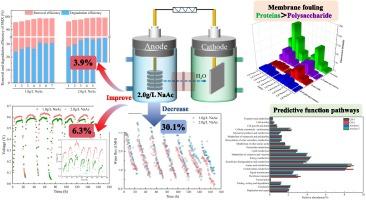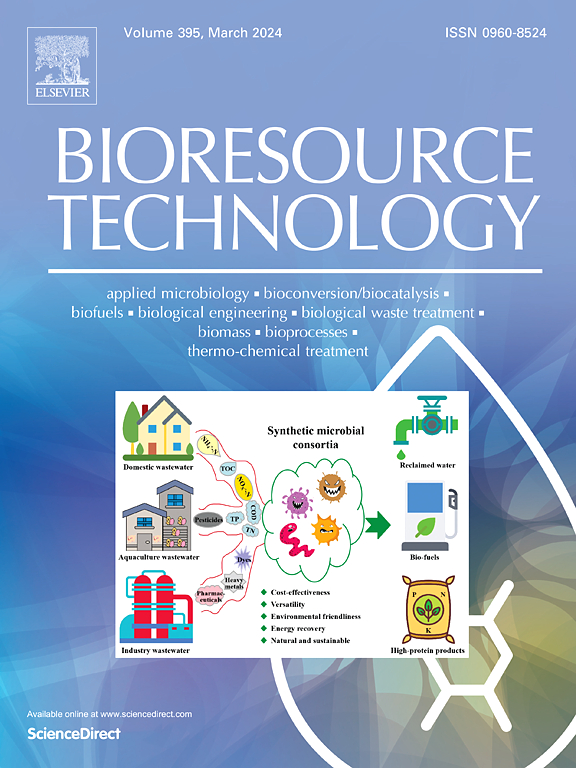Effect of substrate concentration on sulfamethoxazole wastewater treatment by osmotic microbial fuel cell: Insight into operational efficiency, dynamic changes of membrane fouling and microbial response
IF 9.7
1区 环境科学与生态学
Q1 AGRICULTURAL ENGINEERING
引用次数: 0
Abstract
To solve the problems of antibiotic pollution, water resources and energy shortage, an osmotic microbial fuel cell (OsMFC) was adopted innovatively to treat antibiotic wastewater containing sulfamethoxazole (SMX), and achieved SMX removal, water production and electricity generation. Substrate concentration was one of the key factors affecting the performances of OsMFC, but there were few relevant studies This study explored the effect of substrate concentration on system performances, clarified the dynamic changes of membrane fouling under different substrate concentrations, and further revealed the response of microbial communities. The results showed that the stable removal efficiency of SMX exceeded 98.8 % due to the efficient interception of forward osmosis (FO) membrane. Compared with the 1.0 g/L NaAc system, the SMX degradation efficiency and maximum output voltage in the 2.0 g/L NaAc system were only increased by 3.9 % and 6.3 %, respectively. However, the initial water flux decreased by 30.1 % in the 7th cycle due to more serious FO membrane fouling. In addition, there were significant differences in the dynamic formation process of FO membrane fouling. Higher substrate concentration increased the relative abundance of Desulfobacterota and Geobacter. Functional prediction analysis showed that increasing substrate concentration promoted carbohydrate metabolism pathways and relative abundance of sulfur respiration functional groups, thereby improving COD and SMX removal rates. However, the biosynthesis of other secondary metabolites was significantly improved, resulting in increased contents of EPS and SMP, which aggravated membrane fouling. Overall, the system performed better when the substrate concentration was 1.0 g/L. This study would provide certain guidance for the performance optimization and membrane fouling mitigation of OsMFC, thereby promoting its practical application in antibiotic wastewater treatment.

底物浓度对渗透微生物燃料电池处理磺胺甲噁唑废水的影响:洞察运行效率、膜污垢动态变化和微生物反应。
为解决抗生素污染、水资源和能源短缺等问题,研究人员创新性地采用渗透微生物燃料电池(Osmotic microbial fuel cell,OsMFC)处理含磺胺甲噁唑(SMX)的抗生素废水,实现了SMX的去除、制水和发电。底物浓度是影响 OsMFC 性能的一个关键因素,而这往往被研究人员所忽视。本研究探讨了底物浓度对系统性能的影响,明确了不同底物浓度下膜结垢的动态变化,并进一步揭示了微生物群落的响应。结果表明,由于正渗透(FO)膜的高效截流作用,SMX 的稳定去除率超过 98.8%。与 1.0 g/L NaAc 系统相比,2.0 g/L NaAc 系统的 SMX 降解效率和最大输出电压仅分别提高了 3.9 % 和 6.3 %。然而,由于 FO 膜污垢更为严重,在第 7 个循环中,初始水通量下降了 30.1%。此外,FO 膜污垢的动态形成过程也存在显著差异。底物浓度越高,脱硫杆菌和地杆菌的相对丰度越高。功能预测分析表明,底物浓度增加会促进碳水化合物代谢途径和硫呼吸功能群的相对丰度,从而提高 COD 和 SMX 去除率。然而,其他次级代谢产物的生物合成明显改善,导致 EPS 和 SMP 含量增加,加剧了膜污染。总体而言,当底物浓度为 1.0 克/升时,该系统的性能更好。这项研究将为 OsMFC 的性能优化和减轻膜污染提供一定的指导,从而促进其在抗生素废水处理中的实际应用。
本文章由计算机程序翻译,如有差异,请以英文原文为准。
求助全文
约1分钟内获得全文
求助全文
来源期刊

Bioresource Technology
工程技术-能源与燃料
CiteScore
20.80
自引率
19.30%
发文量
2013
审稿时长
12 days
期刊介绍:
Bioresource Technology publishes original articles, review articles, case studies, and short communications covering the fundamentals, applications, and management of bioresource technology. The journal seeks to advance and disseminate knowledge across various areas related to biomass, biological waste treatment, bioenergy, biotransformations, bioresource systems analysis, and associated conversion or production technologies.
Topics include:
• Biofuels: liquid and gaseous biofuels production, modeling and economics
• Bioprocesses and bioproducts: biocatalysis and fermentations
• Biomass and feedstocks utilization: bioconversion of agro-industrial residues
• Environmental protection: biological waste treatment
• Thermochemical conversion of biomass: combustion, pyrolysis, gasification, catalysis.
 求助内容:
求助内容: 应助结果提醒方式:
应助结果提醒方式:


